Standard Permission Types
There are six standard permission types which apply to files and folders in Windows:
- Full Control
- Modify
- Read & Execute
- List Folder Contents
- Read
- Write
Each level represents a different set of actions users can perform. See the table below for more information.
For folders you can also set your own unique permissions or create a variation on any of the standard permission levels. Within each of the permission levels are many possible variations. For information on some of these advanced options, refer to Advanced Folder Level Permissions below.
The following table represents the available standard permission types.
| Permission | Description |
|---|
| Full Control | Permits the user(s) to:- view file name and subfolders.
- navigate to subfolders.
- view data in the folder's files.
- add files and subfolders to the folder.
- change the folder's files.
- delete the folder and its files.
- change permissions.
- take ownership of the folder and its files.
|
|---|
| Modify | Permits the user(s) to:- view the file names and subfolders.
- navigate to subfolders.
- view data in the folder's files.
- add files and subfolders to the folder.
- change the folder's files.
- delete the folder and its files.
- open and change files.
|
|---|
| Read & Execute | Permits the user(s) to:- view file names and subfolder names.
- navigate to subfolders.
- view data in the folder's files.
- run applications.
|
|---|
| List Folder Contents | Permits the user(s) to:- view the file names and subfolder names.
- navigate to subfolders.
- view folders.
- does not permit access to the folder's files.
|
| Read | Permits the user(s) to:- view the file names and subfolder names.
- navigate to subfolders.
- open files.
- copy and view data in the folder's files.
|
| Write | The Read permissions, plus permits the user(s) to:- create folders.
- add new files.
- delete files.
|
Create a New Folder
In many cases you will need to create a new folder. If you are using an existing folder and do not wish to create a new folder, continue with Accessing the Properties Dialog Box.
- Click on the Start menu.
- Click Computer.
- From the Computer window, select the shared drive for your area or department (S Drive or W Drive).
- Navigate to the location you want the new folder to appear (e.g., within one of your existing folders).
- On the menu bar, select New Folder.
OR
Right click » select New » select Folder.
A new folder is created which inherits the security permissions of its "parent."
- In the newly created folder, type the desired folder name.
- Press [Enter] or click off of the folder.
Accessing the Properties Dialog Box
When working with permissions in Windows 7, you are required to work from the Properties dialog box. This dialog box for the file or folder you are working with can be accessed in a few steps.
- Click on the Start menu.
- Click Computer.
- Select the folder or file you wish to adjust/view permissions for.
- Right-click the folder or file.
- Select Properties.
The Properties dialog box appears.
Granting Access to a File or Folder
After creating a new folder, or even if you will use an existing folder, you will need to determine who will have access to it. Also, keep in mind that by default the same persons who have access to the "parent" (original) folder also have access to the new folder, and vice versa. This may not be ideal. It is a simple process to grant access to specific users for any folder you have created.
- Access the Properties dialog box.
- Select the Security tab.
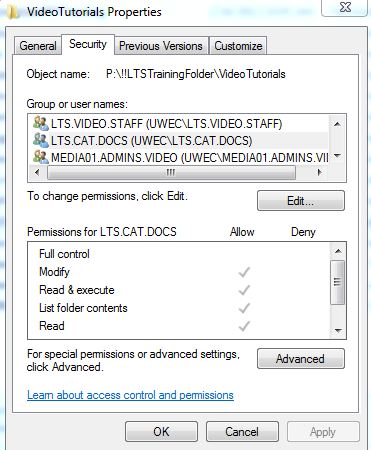
- Click Edit.
The security tab opens in a new window.
- Click Add...
The Select Users, Computers, or Groups dialog box appears.
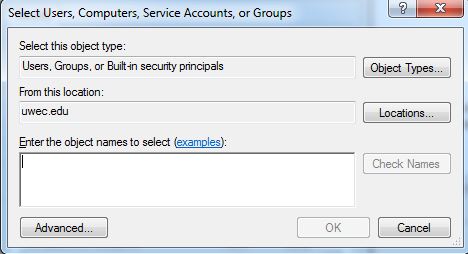
- In the Enter the object names to select text box, type the name of the user or group that will have access to the folder (e.g., 2125.engl.498.001 or username@uwec.edu).
HINT: You may type the beginning of the name and then click Check Names. The name will either be resolved or a list of users beginning with those characters will display for you to select from.
- Click OK.
The Properties dialog box reappears.
- Click OK on the Security window.
- Continue with Setting Permissions below.
Setting Permissions
Once you have granted a group or individual user access to a folder, you will need to set permissions for the new user(s). When you set permissions, you are specifying what level of access a user(s) has to the folder and the files within it. Be careful about checking Deny for any permissions, as the Deny permission overrides any other related to Allow permissions.
Folder permissions can be changed only by the owner of the folder (i.e., the creator) or by someone who has been granted permission by the owner. If you are not the owner of the folder or have not been granted permission by the owner, all checkboxes will be gray. Therefore, you will not be able to make any changes until the owner grants you permission.
- Access the Properties dialog box.
- Select the Security tab.
The top portion of the dialog box lists the users and/or groups that have access to the file or folder.
- Click Edit

- In the Group or user name section, select the user(s) you wish to set permissions for
- In the Permissions section, use the checkboxes to select the appropriate permission level
- Click Apply
- Click Okay
The new permissions are added to the file or folder.
Advanced Folder Level Permissions
When you set permissions, you specify what users are allowed to do within that folder, such as save and delete files or create a new folder. You are not limited to choosing one of the standard permissions settings (Full Control, Modify, Read & Execute, List Folder Contents, Read, or Write). Instead of choosing one of these settings, you may set your own unique permissions based on what you would like users to be able to do. For an understanding of how options can be combined, refer to Permission Types: An Overview.
Remember, folder permissions can only be changed by the owner of the folder (i.e., the creator) or by someone who has been granted permission by the owner. If you are not the owner of the folder or have not been granted permission by the owner, the checkboxes will be grayed out. Therefore, you will not be able to make any changes until the owner grants you permission.
- Access the Properties dialog box
- Select the Security tab
- Near the bottom right of the Properties dialog box, click Advanced
The Advanced Security Settings dialog box appears.
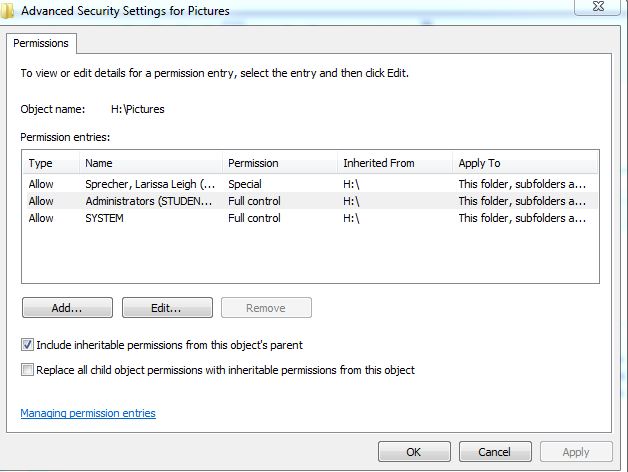
- (Optional) If you do not want the new folder to have the same permissions as the "parent" (original) folder and wish to set unique permissions for the new folder, click the Change Permission button near the bottom. This will bring up a similar window.
- Uncheck the Include inheritable permissions from this object's parent checkbox
A Windows Security warning dialog box will appear.
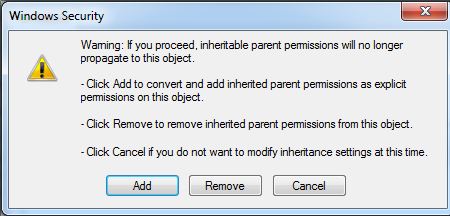
- Click Remove if you want someone removed from permission all together
NOTE: Read the instructions carefully and choose the action you wish to have taken for permissions.
- Click the Change Permissions button
- Select the appropriate user
OR
Click Add and enter the name of the user or group that will have access to the folder.
- Click Edit...
The Permissions Entry dialog box appears.
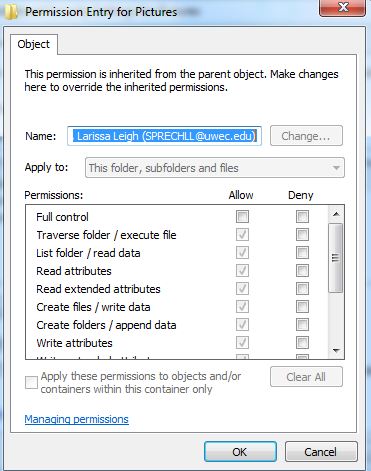
- In the Permissions section, use the checkboxes to set the appropriate permissions
NOTE: If you are not the owner of the folder or have not been granted permission by the owner, all checkboxes will be gray. Therefore you will not be able to make any changes until the owner grants you permission to do so.
- From the Apply to: pull-down list, select what level you wish to apply these permissions to
- Click OK
- In the Advanced Security Setting dialog box, click OK
- Click OK from the duplicate Advanced Security Settings
- In the Properties dialog box, click OK
The new folder permissions are added for your specified user(s).